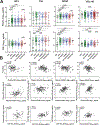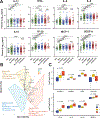Vascular injury markers associated with cognitive impairment in people with HIV on suppressive antiretroviral therapy
- PMID: 37503603
- PMCID: PMC10615701
- DOI: 10.1097/QAD.0000000000003675
Vascular injury markers associated with cognitive impairment in people with HIV on suppressive antiretroviral therapy
Abstract
Objective: Human immunodeficiency virus (HIV)-associated neurocognitive disorders (HAND) remain prevalent despite viral suppression on antiretroviral therapy (ART). Vascular disease contributes to HAND, but peripheral markers that distinguish vascular cognitive impairment (VCI) from HIV-related etiologies remain unclear.
Design: Cross-sectional study of vascular injury, inflammation, and central nervous system (CNS) injury markers in relation to HAND.
Methods: Vascular injury (VCAM-1, ICAM-1, CRP), inflammation (IFN-γ, IL-1β, IL-6, IL-8, IL-15, IP-10, MCP-1, VEGF-A), and CNS injury (NFL, total Tau, GFAP, YKL-40) markers were measured in plasma and CSF from 248 individuals (143 HIV+ on suppressive ART and 105 HIV- controls).
Results: Median age was 53 years, median CD4 + cell count, and duration of HIV infection were 505 cells/μl and 16 years, respectively. Vascular injury, inflammation, and CNS injury markers were increased in HIV+ compared with HIV- individuals ( P < 0.05). HAND was associated with increased plasma VCAM-1, ICAM-1, and YKL-40 ( P < 0.01) and vascular disease ( P = 0.004). In contrast, inflammation markers had no significant association with HAND. Vascular injury markers were associated with lower neurocognitive T scores in age-adjusted models ( P < 0.01). Furthermore, plasma VCAM-1 correlated with NFL ( r = 0.29, P = 0.003). Biomarker clustering separated HAND into three clusters: two clusters with high prevalence of vascular disease, elevated VCAM-1 and NFL, and distinctive inflammation profiles (CRP/ICAM-1/YKL-40 or IL-6/IL-8/IL-15/MCP-1), and one cluster with no distinctive biomarker elevations.
Conclusions: Vascular injury markers are more closely related to HAND and CNS injury in PWH on suppressive ART than inflammation markers and may help to distinguish relative contributions of VCI to HAND.
Copyright © 2023 Wolters Kluwer Health, Inc. All rights reserved.
Conflict of interest statement
The authors declare that they have no competing interests.
Figures



Update of
-
Vascular injury markers associated with cognitive impairment in people with HIV on suppressive antiretroviral therapy.medRxiv [Preprint]. 2023 Jul 24:2023.07.23.23293053. doi: 10.1101/2023.07.23.23293053. medRxiv. 2023. Update in: AIDS. 2023 Nov 15;37(14):2137-2147. doi: 10.1097/QAD.0000000000003675. PMID: 37546734 Free PMC article. Updated. Preprint.
Similar articles
-
CSF Extracellular Vesicle Aβ42 and Tau/Aβ42 Ratio Are Associated with Cognitive Impairment in Older People with HIV.Viruses. 2023 Dec 31;16(1):72. doi: 10.3390/v16010072. Viruses. 2023. PMID: 38257772 Free PMC article.
-
Vascular injury markers associated with cognitive impairment in people with HIV on suppressive antiretroviral therapy.medRxiv [Preprint]. 2023 Jul 24:2023.07.23.23293053. doi: 10.1101/2023.07.23.23293053. medRxiv. 2023. Update in: AIDS. 2023 Nov 15;37(14):2137-2147. doi: 10.1097/QAD.0000000000003675. PMID: 37546734 Free PMC article. Updated. Preprint.
-
CSF Inflammation Markers Associated with Asymptomatic Viral Escape in Cerebrospinal Fluid of HIV-Positive Individuals on Antiretroviral Therapy.Viruses. 2023 Aug 29;15(9):1829. doi: 10.3390/v15091829. Viruses. 2023. PMID: 37766236 Free PMC article.
-
Peripheral immune dysregulation in the ART era of HIV-associated neurocognitive impairments: A systematic review.Psychoneuroendocrinology. 2020 Aug;118:104689. doi: 10.1016/j.psyneuen.2020.104689. Epub 2020 May 29. Psychoneuroendocrinology. 2020. PMID: 32479968
-
Plasma neuronal exosomes serve as biomarkers of cognitive impairment in HIV infection and Alzheimer's disease.J Neurovirol. 2019 Oct;25(5):702-709. doi: 10.1007/s13365-018-0695-4. Epub 2019 Jan 4. J Neurovirol. 2019. PMID: 30610738 Free PMC article. Review.
Cited by
-
Multi-modal analysis of inflammation as a potential mediator of depressive symptoms in young people with HIV: The GOLD depression study.PLoS One. 2024 Feb 22;19(2):e0298787. doi: 10.1371/journal.pone.0298787. eCollection 2024. PLoS One. 2024. PMID: 38386679 Free PMC article.
-
Plasma Neurofilament Light Chain and Glial Fibrillary Acidic Protein as Biomarkers of Cognitive Decline in People With Human Immunodeficiency Virus.J Infect Dis. 2025 Apr 15;231(4):946-956. doi: 10.1093/infdis/jiae623. J Infect Dis. 2025. PMID: 39723835
-
CSF Extracellular Vesicle Aβ42 and Tau/Aβ42 Ratio Are Associated with Cognitive Impairment in Older People with HIV.Viruses. 2023 Dec 31;16(1):72. doi: 10.3390/v16010072. Viruses. 2023. PMID: 38257772 Free PMC article.
-
Maternal and child immune profiles are associated with neurometabolite measures of early-life neuroinflammation in children who are HIV-exposed and uninfected: a South African birth cohort.bioRxiv [Preprint]. 2025 Mar 19:2025.03.17.643628. doi: 10.1101/2025.03.17.643628. bioRxiv. 2025. PMID: 40166324 Free PMC article. Preprint.
-
HIV-Associated Neurocognitive Disorder: A Look into Cellular and Molecular Pathology.Int J Mol Sci. 2024 Apr 25;25(9):4697. doi: 10.3390/ijms25094697. Int J Mol Sci. 2024. PMID: 38731913 Free PMC article. Review.
References
-
- Wang Y, Liu M, Lu Q, et al. Global prevalence and burden of HIV-associated neurocognitive disorder: A meta-analysis. Neurology 2020; 95:e2610–e21. - PubMed
-
- Nightingale S, Dreyer AJ, Saylor D, Gisslen M, Winston A, Joska JA. Moving on from HAND: why we need new criteria for cognitive impairment in people with HIV and a proposed way forward. Clin Infect Dis 2021. - PubMed
-
- Winston A, Spudich S. Cognitive disorders in people living with HIV. Lancet HIV 2020; 7:e504–e13. - PubMed
Publication types
MeSH terms
Substances
Grants and funding
LinkOut - more resources
Full Text Sources
Medical
Research Materials
Miscellaneous

